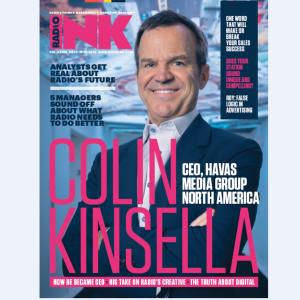
(By Editor-In-Chief Ed Ryan) Colin Kinsella is CEO at Havas Media Group North America, an award-winning global media network operating in over 140 countries worldwide. Havas clients include Disney, PayPal, Michelin, Dish, Bristol-Myers Squibb, and 21st Century Fox.
Before joining Havas Kinsella was CEO at Mindshare North America, a division of WPP’s GroupM unit. During his tenure at Mindshare, he managed big-time clients, including Volvo, American Express, Unilever, and Nordstrom. He’s also held leadership roles at Digitas, Razorfish, Foote, Cone & Belding, and QuinStreet.
Under Kinsella’s leadership Havas was named Adweek’s 2016 U.S. Media Agency of the Year and MediaPost’s 2017 U.S. Media Agency of the Year — and in 2014, the innovative work produced by the company’s North American offices captured an amazing 34 industry awards. Kinsella’s also been recognized individually for his work: MediaPost named him a Digital All Star in 2015.
And the best thing about Kinsella, as far as the radio industry is concerned? He loves radio and cannot understand why more big brands aren’t using it.
Radio Ink: How and why did you get started in media?
Kinsella: I graduated college in pre-med and history, only to realize that to become a doctor, I would have to take a standardized test, which I hated. I realized I did not want to put my career into a trajectory that had to do with standardized testing.
I ended up getting a Myers-Briggs test, which told me my profile had a creative brain and I 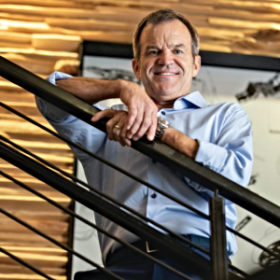 should work at an ad agency. I went to an ad agency and told them this test said I should work there. They laughed, but I said I would work for free if they would just give me time to interview. They did, and I got a job six weeks later. That original firm hired me full-time. That’s how I got in advertising.
should work at an ad agency. I went to an ad agency and told them this test said I should work there. They laughed, but I said I would work for free if they would just give me time to interview. They did, and I got a job six weeks later. That original firm hired me full-time. That’s how I got in advertising.
I worked in St. Louis for four or five years and then moved to Chicago, which most people [in advertising] do. I worked at Foote, Cone & Belding, which had creative and media together — I did account management for packaged goods. We did a lot of TV, radio, traditional media at the time. I moved to Europe to run Africa, Europe, and the Middle East from London for two years. I then went to San Francisco and worked in their most creative agency.
It was there we did more interesting account planning, deeper strategy, finding ways to connect holistically around a brand. I did that for four years, and then the dot-com world blew up. I got an offer from Razorfish — it was called Avenue A back then. I ended up taking that job and ran Razorfish for five years on the West Coast. We got bought by Publicis, and I moved to New York with that purchase in 2010. I worked at Digitas as CEO and ran that for three years; I really got into digital branding and CRM, performance marketing, and how to pull it all together.
I realized something was missing, and I thought those agencies were going too far with social media and data and were not going to survive just doing that. If you were ever going to change clients’ points of view, you needed to change how they spent their money. I felt the real leverage in the marketplace was moving toward media.
In 2013 I left Digitas and went to Mindshare and dug into media in a way I had never done before. I did it because I felt media was the place to change the business of how clients market their brands. I worked there for a few years, and we won some great business, like Nordstrom, Volvo, Blackrock, General Mills, over the course of three years.
Even as I was winning, it felt like something was missing, and that was the connection to creative — and how do you go back to what used to work well inside an agency that was putting creative and media back together? I met with Yannick Bollore, and I loved the notion of “the village.” I thought there was something positive going on at Havas. I interviewed there and got the job.
I have been CEO of Havas for the last 2 1/2 years. It has been a great ride. We have won Media Agency of the Year two years in a row from two different publications. We are winning a lot of new business now. We have a great set of new clients who leverage radio in new and interesting ways. We have some clients incredibly bullish on radio. When I get a chance to talk about radio with someone like you or in a conference, I’m always willing to raise my hand because I believe there is incredible power in radio.
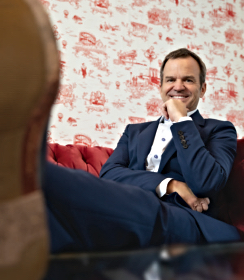 Radio Ink: Did you always want to be a CEO?
Radio Ink: Did you always want to be a CEO?
Kinsella:If you asked me when I was under 30, I would have said no. It wasn’t in my head. After 30, I would’ve thought that would be nice, but looking at the people ahead of me and how long it was taking them to get there, I thought the odds were low. I didn’t think about it much until I was 40.
I was in San Francisco running the AT&T business, and I lost that piece of business, the week before my 40th birthday. I had a moment and realized the only way to get ahead was to run an office well, and then run more offices well, etc. In my early 40s, I thought about being a president or CEO.
Radio Ink: What is the key to being successful in a company like yours, with the
people you manage, the accounts your people are in charge of, and the changing of media?
Kinsella: I have, knock on wood, a clear philosophy about how you manage in a creative environment. It is really four things I think about all the time. The first one is about respect. I make it clear to people, regardless of where they are in the hierarchy, that their time is as valuable as my time is. I mean that.
I start every meeting on time, and if I don’t, I end it on time so I’m ready for the next person. I send thank you notes to people. Outside suppliers come to meet with me, and I’m available at the scheduled time. It permeates the agency that I function on a timely basis. The culture will shift as they realize if he can do it, I should, too.
I don’t spring crazy meetings in the middle of the day. I had a boss that used to prattle on and on, and I was thinking I was supposed to call a client 10 minutes ago — now I look bad, and the agency looks bad, because my boss isn’t disciplined. There’s a direct correlation between being disciplined and being successful.
My next big thing is the notion of listening with positive intent. We are all moving fast, and if you think someone gave you a slight, how do you work your way past that? I’m convinced people hate drama. They hate having a pit in their stomach at night. It’s incredibly difficult to be open, creative, and an active part of a group if you’re feeling angst.
Part of the boss’ job, and my job in particular, is to remove angst from people. Make sure people know where and what they’re supposed to be doing, give them encouragement and feedback, but feel like you’re in it with them — if they’re not performing, that you’re there to help them get better. Having that safety net makes people more relaxed, and they are more creative.
Fourth, I’m prone to action. I like to do things. I don’t like to just read e-mails, I want to create stuff. We are a media agency. Your job isn’t to write e-mails and do Power Points. It’s to put the right piece of creative at the right place, right time, on the right device so people are exposed to our client’s brand in ways that move them to take action.
Radio Ink: What is the biggest mistake managers make?
Kinsella: To give too little or too much direction.
Radio Ink: You said some clients are bullish on radio. Can you explain why?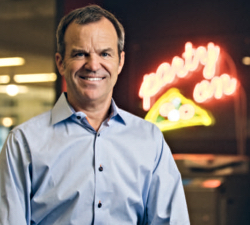
Kinsella: Certain clients realize it really works. I have found that clients that spend a lot of money on radio end up having better performance from radio. It might be that they’ve concentrated on where that message is best served.
When I think of Dos Equis, an account that used to be here, the use of radio was very clever. They had a small budget and tried to advertise as little as possible in the hopes that people would be so enamored they would go see it themselves online. So you wouldn’t spend that much in the marketplace, because you had powerful advertising and you could try to get people to see it on their own, but in a space that was free.
Instead of spending money on TV, they did it on radio, with the campaign about the “Most Interesting Man in the World.” For a lot of people, they couldn’t get out of the car until the ad was over because it was so cleverly done. For clients who think radio is not for them, I always looked at that, a beer brand, and how you could use the medium for anything.
It seems to me that radio was the first social network — you just couldn’t talk back to it. And radio could do things faster than anyone else. I worked with iHeart-Radio on a program that was based on speed. For example, we would get wind on a Friday that one of the Volvo cars was going to be in the Wall Street Journal on Saturday. With radio, you could quickly turn around and let people know that this was going to be in the Journal, run ads to let people know to check out the car that was talked about in the Journal. I worked with iHeart and found out that it would only take 28 minutes to get a piece of news that was positive on the air. We could get Ryan Seacrest to read anything.
We started to put a lot of interesting programs together about the speed of radio. Something would happen the night before, and in the morning the DJs would talk about it and you would get your brand connected to that story very quickly and meaningfully. We at Havas are all about meaningful data.
Radio Ink: The clients that you talk with who are not bullish on radio — why is that?
Kinsella: It depends on the category they are in. The big issue we see in radio is that planners who are probably in New York commute to work. When you commute in NYC, you do so via trains or subways, so for them terrestrial radio does not exist. When it comes to putting money in a plan to drive action, their last instinct is radio. It’s one of the few mediums they don’t have a connection to. They have more of a connection to music like Spotify and ad-supported music. The real bulk of radio, they don’t have exposure to it.
Radio Ink: How do we fix that?
Kinsella: I don’t know. You do an off-site and stick them in cars in Columbus, Ohio, during rush hour.
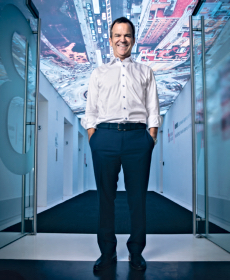 Radio Ink: What is going on in the world of media these days?
Radio Ink: What is going on in the world of media these days?
Kinsella: We are in this whole paradox of choice right now. There is so much to do, so let’s try it all. There is the “spreading of the peanut butter theory” that says no one has ever been successful putting little bets everywhere. You have to be at some level, from a client’s perspective, a risktaker. You then need data to support that risk-taking.
A lot of clients, unless they are in an area where there is traditionally heavy usage of radio, will struggle. I have walked into a pitch in which I went in with radio as one of the top three media avenues and the clients said, “No way.”
The only way to get past that is promoting success stories that have leveraged radio. We have AutoZone as a client, and they leverage radio in an incredibly aggressive way, but oddly enough, so does the category — NAPA, O’Reilly also do. You can imagine if they are going heavy, then fast foods should be heavy, and all manner of clients should be. Starbucks should be. Yet the only ones are auto-related aftermarket.
Radio Ink: Is digital all it’s cracked up to be?
Kinsella: Data isn’t what people think it is. I think people are spending way too much on data and not enough time thinking creatively what they would do if it was their business. On the Google side, it’s tough because it is very effective — it is effective on the lower half of the funnel.
For the first time ever, GDP is going up while investment in brands is going down. You think that’s crazy, but if investmentsb are going down, it’s because the brands don’t feel they’re getting the value out of the money anymore. They then turn to another platform, and that’s digital. It was the most economical media, and somehow, some way, it became the least economical media. There’s a lot of waste and fraud inside digital, whether it’s bots or a “long tail” that didn’t exist.
One of the best things about radio is it is real. It is there and you hear it. The fact people aren’t talking about advertising the way they used to is the reason brands aren’t doing as well as they used to. We have to get brands to break out of the cycle. If I was in radio, I would want radio to be the cycle-breaker. Do something with a brand that really pushes them to take that risk to see if you can break the chain.
Radio Ink: Do you think radio is creative enough?
Kinsella: No. The best creative for radio that people have heard is either Motel 6 or Dos Equis. Think of the power of that advertising. And radio is still relatively inexpensive. Creatives get more money, praise, or reputation if they do really big advertising.
I don’t know what the last 10 winning radio spots were, but my thought is that you look at those and figure out how to build on top of them. We know creative matters for clients. We need that pressure on radio to get people to stop in their car and say, “That was awesome.”
Radio Ink: Does it worry you when you are in the car and you hear 10 or 12 commercials in a row?
Kinsella: Yes. I would change it. Bob Pittman would tell me most people change the dial based on the fact that they don’t like the song that came on. Those are systemic problems I have not put my brain to yet. It’s a tough one. How do you fill the load to make enough money to keep it all going?
Radio Ink: If you had an advertiser buried as the seventh or eighth commercial in that pod, how would that work for a client?
Kinsella: You would assume it doesn’t work.
Radio Ink: Are you OK with the measurement system of radio?
Kinsella: I think everybody is trying something new, and the more you try, the better. I think it would be better if there was some arbiter. We all have Nielsen ratings. We all have an ability to test out advertising versus competition.
I think the best marker of success is to highlight a city or two in which you’re advertising, and the thing you change is to add radio to that mix to see if you move sales. If sales are purchased on a weekly basis, you do it for two months. If on a quarterly basis, then you do it for six to nine months. This is so you can get a feel for whether radio can drive business, as opposed to driving an advertising marker.
Radio Ink: You mentioned data a few times. What data do you want to see from radio?
Kinsella: I would like a radio sales executive to come to me and show me three different clients in three different categories that spent three times more on radio and tell me the results — sales results.
Radio Ink: Give the radio industry advice on how to increase revenue.
Kinsella: Demand the clients you’re working with do better creative work. Don’t allow crap advertising on your medium. It is up to them how to sort that out. It is so easy to me, philosophically, for radio to become hip. It’s the notion that radio is so old, it’s hip. The Ryan Seacrests and Rush Limbaughs of the world, there are huge personalities in radio, and the advertising that is on some of them is not good.
Radio has to say, “We’re not putting you on unless it’s good.” The stuff you hear in a 10-pod radio break is what drives people crazy. It is out of touch. Your DJs are the most in-touch people in the country. You can leverage them at store openings. I can’t fathom why it’s not better.
Radio Ink: What advice do you have for radio salespeople?
Kinsella: Keep your chin up; you have a great medium to sell. The more you can help your clients produce great work, the more that will position you as invaluable with your station or group.
Radio Ink: What are your thoughts about podcasting?
Kinsella: I don’t think they’re charging enough money — that seems weird coming from the media side of the house. If you have Malcolm Gladwell on a podcast, there’s no reason Indeed.com should be running. Malcolm should have completely different advertisers on because it’s him. He should be charging a lot of money. It should be, “I can’t afford to get on Malcolm’s show. I wish I could because he could change the trajectory of my brand.”
Radio Ink: Do you think podcasting is going anywhere? Are you buying ads on podcasts?
Kinsella: Yes. I think it has a future. It’s undervaluing itself, and I think that’s hurting the medium. There is some version of scarcity, and there are some brands around it like [David Axelrod’s] Axe Files. There is real value in that, and real brand propensity around that. I think Unilever should be connected to those kinds of media.
Radio Ink: Any final advice for our radio audience?
Kinsella: Radio should push hard on digital’s inability to fulfill its promise. A lot of people put money into digital because the early view was very positive. It was so positively reinforced — every time you did a Google campaign, you got people to react to it and come into your brand and convert. I think everybody started to feel like digital was the same thing as Google.
When Facebook came out, it was real people and you could talk to them. They would react to a piece of advertising that they did or did not like, and that also drove the brand quickly. You had Google and Facebook doing something that was really driving value, and now you have Amazon driving value.
But you also have a lot of digital stuff not driving value, and brands are having a hard time separating the wheat from the chaff. I think a lot of brands internally, brands that have people driving around in their cars, should be finding ways to talk to clients about spending more in radio than on digital.
You could blame it on digital blindness or that there are too many ads on the phone or that we don’t multitask the way we think we do. The brands are not penetrating the way they should or hoped. Go back to using radio as the alternative, as digital is not working, and convince them they should use more radio and less digital.
PHOTOS: SEAN T. SMITH/SIMON LUETHI






Put your skills to the test and solve four words at once! Play quordle now!
thanku for this